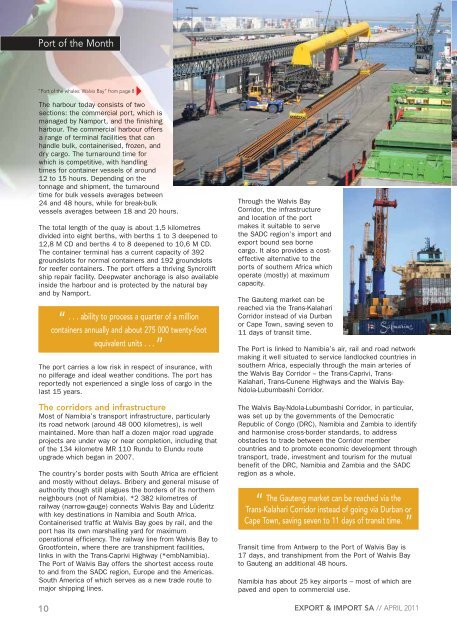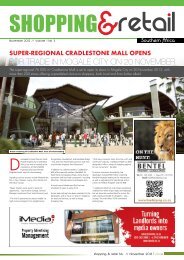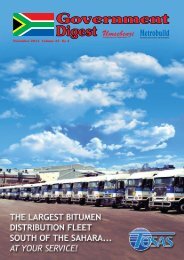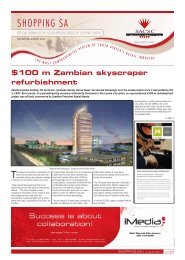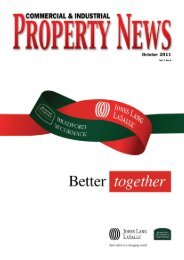April 2011 - Malnor
April 2011 - Malnor
April 2011 - Malnor
You also want an ePaper? Increase the reach of your titles
YUMPU automatically turns print PDFs into web optimized ePapers that Google loves.
Port of the Month<br />
“Port of the whales: Walvis Bay” from page 8<br />
The harbour today consists of two<br />
sections: the commercial port, which is<br />
managed by Namport, and the finishing<br />
harbour. The commercial harbour offers<br />
a range of terminal facilities that can<br />
handle bulk, containerised, frozen, and<br />
dry cargo. The turnaround time for<br />
which is competitive, with handling<br />
times for container vessels of around<br />
12 to 15 hours. Depending on the<br />
tonnage and shipment, the turnaround<br />
time for bulk vessels averages between<br />
24 and 48 hours, while for break-bulk<br />
vessels averages between 18 and 20 hours.<br />
The total length of the quay is about 1,5 kilometres<br />
divided into eight berths, with berths 1 to 3 deepened to<br />
12,8 M CD and berths 4 to 8 deepened to 10,6 M CD.<br />
The container terminal has a current capacity of 392<br />
groundslots for normal containers and 192 groundslots<br />
for reefer containers. The port offers a thriving Syncrolift<br />
ship repair facility. Deepwater anchorage is also available<br />
inside the harbour and is protected by the natural bay<br />
and by Namport.<br />
The port carries a low risk in respect of insurance, with<br />
no pilferage and ideal weather conditions. The port has<br />
reportedly not experienced a single loss of cargo in the<br />
last 15 years.<br />
The corridors and infrastructure<br />
Most of Namibia’s transport infrastructure, particularly<br />
its road network (around 48 000 kilometres), is well<br />
maintained. More than half a dozen major road upgrade<br />
projects are under way or near completion, including that<br />
of the 134 kilometre MR 110 Rundu to Elundu route<br />
upgrade which began in 2007.<br />
The country’s border posts with South Africa are efficient<br />
and mostly without delays. Bribery and general misuse of<br />
authority though still plagues the borders of its northern<br />
neighbours (not of Namibia). *2 382 kilometres of<br />
railway (narrow-gauge) connects Walvis Bay and Lüderitz<br />
with key destinations in Namibia and South Africa.<br />
Containerised traffic at Walvis Bay goes by rail, and the<br />
port has its own marshalling yard for maximum<br />
operational efficiency. The railway line from Walvis Bay to<br />
Grootfontein, where there are transhipment facilities,<br />
links in with the Trans-Caprivi Highway (*embNamibia).<br />
The Port of Walvis Bay offers the shortest access route<br />
to and from the SADC region, Europe and the Americas.<br />
South America of which serves as a new trade route to<br />
major shipping lines.<br />
10<br />
“ . . . ability to process a quarter of a million<br />
containers annually and about 275 000 twenty-foot<br />
equivalent units . . . ”<br />
Through the Walvis Bay<br />
Corridor, the infrastructure<br />
and location of the port<br />
makes it suitable to serve<br />
the SADC region’s import and<br />
export bound sea borne<br />
cargo. It also provides a costeffective<br />
alternative to the<br />
ports of southern Africa which<br />
operate (mostly) at maximum<br />
capacity.<br />
The Gauteng market can be<br />
reached via the Trans-Kalahari<br />
Corridor instead of via Durban<br />
or Cape Town, saving seven to<br />
11 days of transit time.<br />
The Port is linked to Namibia’s air, rail and road network<br />
making it well situated to service landlocked countries in<br />
southern Africa, especially through the main arteries of<br />
the Walvis Bay Corridor – the Trans-Caprivi, Trans-<br />
Kalahari, Trans-Cunene Highways and the Walvis Bay-<br />
Ndola-Lubumbashi Corridor.<br />
The Walvis Bay-Ndola-Lubumbashi Corridor, in particular,<br />
was set up by the governments of the Democratic<br />
Republic of Congo (DRC), Namibia and Zambia to identify<br />
and harmonise cross-border standards, to address<br />
obstacles to trade between the Corridor member<br />
countries and to promote economic development through<br />
transport, trade, investment and tourism for the mutual<br />
benefit of the DRC, Namibia and Zambia and the SADC<br />
region as a whole.<br />
“ The Gauteng market can be reached via the<br />
Trans-Kalahari Corridor instead of going via Durban or<br />
Cape Town, saving seven to 11 days of transit time. ”<br />
Transit time from Antwerp to the Port of Walvis Bay is<br />
17 days, and transhipment from the Port of Walvis Bay<br />
to Gauteng an additional 48 hours.<br />
Namibia has about 25 key airports – most of which are<br />
paved and open to commercial use.<br />
EXPORT & IMPORT SA // APRIL <strong>2011</strong>


